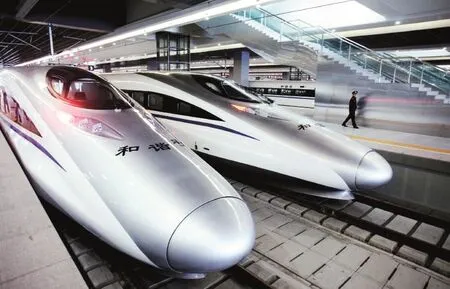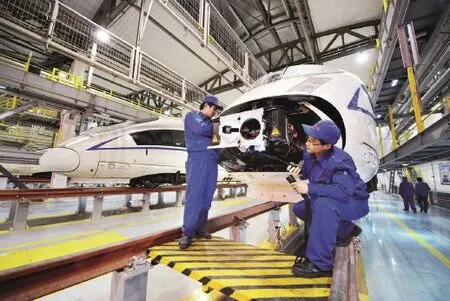Market Competitiveness of China’s High-speed Rail
2016-09-26ByXuHao
By Xu Hao
Market Competitiveness of China’s High-speed Rail
By Xu Hao

The Shanghai-Hangzhou high speed train started to run formally on October 26, 2010. CHR Harmony CRH 380A berths at the Shanghai Railway Station.
China has the world's most sophisticated, also the most developed high-speed rail system. Its research and development capability for locomotives, tracks,electric supply and communication systems are top of the class. When the world is restructuring division of labor, China's high-speed rail industry has both motivation and power going abroad.
About China's competitiveness, said Sheng Guangzu, general manager of China Railway Corporation, “With proprietary intellectual property rights China's highspeed rail products are quite advanced. Tey are practical in use and lower in price. Technology, management experience and cost control make China's strong competitiveness.
What he said is supported by a report from the World Bank: “Technical and knowledge transfer plus the experience from building and managing operations on thousands of kilometers of high-speed lines has left China advanced technologically. When other countries are starting, China is quite competitive already.
Technological advantage

Two workers conducted maintenance on a CRH train in December 2013.
High-speed rail technology involves two parts: individual equipment or parts, and integration of different systems. Over the past decade, by innovation, integration,introduction and di -gestion of foreign technology for re-innovation, China has made many signifcant achievements of its own. The technological system China has is advanced in the world and this is why China is competitive in this feld.
Take the train unit model 380 CSN developed as an example. It has been authenticated in the U.S. Former board chairman of CSN Zhao Xiaogang had used high-speed rail in both Japan and Germany. When their trains traveled at 270 kilometers per hour, he said, a passenger coach shook terribly. But the train CSN developed was stable even at 300 kilometers per hour and the sound control on board was much better. By people from CNR,the technology for their CRH3, CRH5 and CRH380B in 380 series for the use in alpine areas is quite mature.
To some experts, China's advantage is shown more on its system integration capability, where CRSC's strong hand is seen. It provides a packaged service for system development and integration, design, equipment making, installation and debugging. This packaged service has benefits: professional management, collection of strong points from other systems, efcient functioning and less work for customers. CTCS-3 (shortened for CTCS-3), a system CRSC developed by its own effort, is the key technology for train control. Every part in the system, from standards making, system development, results tests, product making, installation and joint debugging is made or integrated in China. Tis is a guarantee for engineering quality. It also saves time and cost.
Apart from signal control technology,China's high-speed rail enterprises are also experienced in locomotive making, bridge building, tunneling, automatic control,overhead line system, safety and operation management.
“Some developed countries started earlier by decades,” Professor Sun Zhang from Tongji University spoke highly of China's fast progress. “But China's technology is more compatible than theirs, with a wide range of speed from 140 km per hour up to 400 km per hour. Te high speed rail from China can run in diferent geological conditions, different countries and different climates. It can meet the toughest challenge from environments.”
In terms of track technology, a highspeed rail measures sedimentation diference by millimeter, as precise as the speedway for F1 Formula One Racing. It is a tough challenge posed by huge geological variation in China: collapsible loess, wetlands and alpine areas. How to solve geolog -ical sedimentation and thermal expansion on the rail? Te section from Nanjing to Shanghai in Beijing-Shanghai High-speed Rail has sof foundation. Its settlement must be kept within 15 millimeters. Te same technology was used for Qinghai-Tibet Railway: building bridges above the ground. Tis method effectively solved the settlement problem. This methods was used for the whole rail between Beijing and Shanghai.
Train control system for example. Te CTCS-3 system CRSC developed has integrated the functions of C2, thus able to make over-line operationfor both C2 and CTCS-3. When radio communication is compromised C2 kicks in as a stand-by mode and the train doesn't even stop to make the change. CTCS-3 or C2, safety surveillance continues and temporary speed limit is practiced in case of bad elements or road construction.
安徽医科大学附属省立医院、安徽省立医院于2017年12月23日更名为中国科学技术大学附属第一医院(安徽省立医院)。因作者发表论文的用途不同,故同期保留了两个不同的单位名称。
Wang Mengshu, academician of Chinese Academy of Engineering, compared Chinese technology with foreign ones. China's, he believes, is more advanced. Take track technology as an example. China has over a thousand kilometers of seamless rails, while Japan, just a couple of hundred. Chinese high-speed rail does not deform when temperature rises to 100 degrees,while neither German nor Japanese one can do. In electric supply system, China's power mains have standing columns spaced out at 50 or 60 meters, 30 meters longer than those in Japan. “No wonder people say,” Wang Mengshu says proudly, “Germany is the best for manufacturing, Japan for electronic appliances, the U.S for space aviation and China, high-speed rail.”
Technology, management experience and cost control make for China's strong competitiveness.
Rich experience in building and operation management
By the end of 2013, China's high-speed rail is over 11,000 kilometers long, half of the total in the world. This operation mileage longer than any country's leaves China advantageous in building and management. Tis is another reason for China'scompetiveness.
The large construction of high-speed rail in China provides to the world more experience and data. While many countries are still doing single-line operation,China has formed a complete network for high-speed rail, starting from planning, designing, building, communicating, systems integration and operation management. Very few nations in the world can do this.
China is experienced in building in difficult geographical conditions, from an alpine area to tropical one, from costal area to Gobi Desert. According to Zhao Guotang, deputy general engineer of CRCC, the adaptation of China's highspeed rail technology is obvious in two aspects: compatible with speed from 200 to 350 kilometers per hour and able to operate in different environments. In China's northeast, temperature may drop to minus 40 centigrade in winter and in the northwest, days of gale-force winds rated eight or above may be as many as 260 a year. In terms of environmental adaptation China's high-speed rail technology is the best.
Take the Sino-Thai high-speed rail project for example. It connects Laos,Tailand, Malaysia and Singapore. Chiang Mai of Tailand is in subtropical zone, hot and humid, which is similar to China's Hainan Island in climate and geological situation, where its eastern ring-line has started operating. The experience China achieved in Hainan helped building the pan-Asia railway.
Good cost efciency
Apart from the largest network in the world, China's highspeed rail is very cost efficient and this is acknowledged across the world.
According to a report from the World Bank published in July 2014, the cost of high-speed rail in China is just 2/3 of that in other countries. Weighted average unit cost per kilometer is 129 million Yuan for a line designed for 350 kilometers per hour, and 87 million Yuan for a line 250 kilometers per hour. But the line between Frankfurt and Cologne cost 300 million Yuan per kilometer, a line in South Korea, 250 million Yuan per kilometer. With the total investment of 220 billion Yuan, the 1,318 kilometers long Beijing-Shanghai rail cost just 160 million Yuan per kilometer.

Young Chinese woman Liu Qian (right) with her mother were on the frst CRH from Yichang to Wuhan, the capital of Hubei Province on July 1, 2012. On the same day, Hankou-Yichang Railway, an important high-speed railway linking Southwest China, ofcially opened. It marks the Sichuan-Hankou railway completed.
According to Shao Renqiang of CSN:“China's advantages in high-speed rail construction are seen in good cost performance and fast delivery term.”
Mass production and technical application also contribute to cost efficiency. The cost for a train unit running at 300 kilometers per hour in China, due to excellent cost control, is less than 30 percent the cost by a foreign builder.
“Lower cost on labor and industrial chain enables China's high-speed rail industry to purchase parts of the same quality at a much lower price,” another CSN ofcial said.
And there are other reasons for China's strong competitiveness. Full use of local resources during construction and production is one. “Using bridges to lead the rail”, a wonderful invention, is another. Take the Beijing-Shanghai high-speed rail as example. 86.5% of the train line is built on bridges, a percentage not to seen anywhere else in the world. Many viaducts used significantly cut the cost on farmers' relocation and land compensation, even though high-rise track cost per unit is higher than that on the ground. Standardized design and production for bridges makes diference. It efectively reduces the chance of roadbed settlement.
The government's plan to have more high-speed rail in the next six or seven years has triggered huge enthusiasm from equipment manufacturers and building companies. Tey have shown huge interest in new technologies and lowered marginal cost. These advantages make foreign competitors envious. According to the general manager of Alston, a Rail Services Firm, China is “very competitive in price,Chinese businesses are well organized and they are backed up by the state bank.”
So far, railway equipment from China is seen in over 100 countries. China is quite established in world market. In terms of equipment making, the market shares CSR and CNR take in the world are 10 percent put together, just behind Bombardier,Siemens and Alston. It is planned that in later half of the 12th five-year development plan, CSR and CNR with advanced technology and lower comprehensive cost,along with even faster delivery time will be the biggest in the world.
